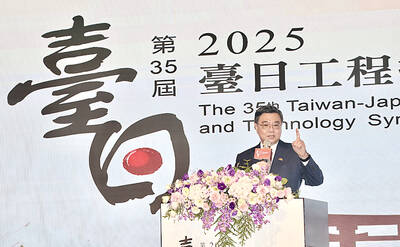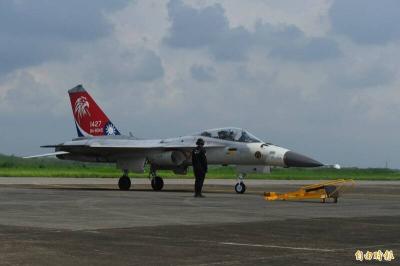The relative calm in the Taiwan Strait since 2008 is one of the principal factors behind China’s increasingly aggressive stance in the South China Sea, a Vietnamese academic told a conference in Washington on Wednesday.
The two-day conference, organized by the Center for Strategic and International Studies (CSIS), was held amid rising tensions in the South China Sea following the announcement by China National Offshore Oil Corp (CNOOC) earlier this week that it was offering nine blocks for joint operation with foreign firms in waters that Vietnam claims fall within its exclusive economic zone (EEZ), prompting Hanoi to lodge an formal protest.
Speakers from China, Vietnam and the Philippines — all claimants in the South China Sea disputes — were invited to give presentations on the subject, while academics from the US, Japan and India, which do not have sovereignty claims in the area, provided external rationales for their involvement in conflict resolution.
No one from Taiwan, one of the six claimant countries, presented at the conference, although officials from the Taipei Economic and Cultural Representative Office (TECRO) attended.
Also present at the conference and a speaker on the second day of the event was Fu Kuen-cheng (傅崑成), a former People First Party legislator in the 1990s who now teaches at the KoGuan Law School at Shanghai Jiaotong University.
Speaking in the afternoon, Tran Truong Thuy of the Center for South China Sea Studies at the Diplomatic Academy of Vietnam argued that the recent stability in the Taiwan Strait following President Ma Ying-jeou’s (馬英九) rapprochement initiative with China from 2008 was a source of new tensions in the region because better relations between Taipei and Beijing had freed up Chinese military assets.
Calling the South China Sea China’s second priority after Taiwan, Tran said improved relations had “allowed China to direct resources and attention to the South China Sea” in ways that would have been impossible prior to 2008.
On Beijing’s historical claims to the entire sea, Tran summed up its policy and opposition to a multilateral approach to conflict resolution to that of a bully.
“What is mine is mine, and what is yours is also mine, but I am willing to share,” he said of Beijing’s position.
Earlier in the day, Henry Bensurto, a former secretary-general of the Commission on Maritime and Ocean Affairs Secretariat under the Philippines’ Department of Foreign Affairs, drew a direct link between rising military investment in the People’s Liberation Army and its claims on the nine-dash line area of the South China Sea and encroachment in waters within the Philippine EEZ, which culminated in the dispute over the Scarborough Shoal (Huangyan Island, 黃岩島) earlier this year.
Manila, he said, has no choice but to respond, partly by seeking assistance from the US, with which it signed a mutual-defense treaty in the 1950s.
“Some people say that if you’re being raped, you might as well enjoy it,” he said of Chinese encroachment on the Philippines’ EEZ. “That’s not our policy.”
Such muscle flexing by China undermines the argument, made by a handful of academics last year, that giving in to China’s claims on Taiwan would ensure that China behaves as a responsible and non-belligerent actor in the future, and gives credence to the theory that “abandoning” Taiwan would only encourage Beijing to adopt a more expansionist policy.
For Tetsuo Kotani, a research fellow at the Japan Institute of International Affairs, China’s future behavior in the South China Sea could serve as an indication of how Beijing would resolve its longstanding dispute with Japan in the East China Sea.
Kotani said he had engaged in discussions with US and Japanese military officials on the possibility of holding joint US-Japan maritime surveillance in the South China Sea to help stabilize the situation.
However, he did not comment on whether Tokyo and Washington were receptive to the idea.
Assistant US Secretary of State for East Asia and the Pacific Kurt Campbell gave the keynote speech during lunch.
Asked by the Taipei Times whether Washington worried about the possibility of cooperation between Taiwan and China in the South China Sea disputes, Campbell guardedly said that US officials had engaged in talks — in an unofficial capacity — with their Taiwanese counterparts, adding that Taipei had been “very careful” with its language on the subject.
Campbell comments nevertheless provided confirmation that the US was liaising with Taiwan on the matter.

LOW RISK: Most nations do not extradite people accused of political crimes, and the UN says extradition can only happen if the act is a crime in both countries, an official said China yesterday issued wanted notices for two Taiwanese influencers, accusing them of committing “separatist acts” by criticizing Beijing, amid broadening concerns over China’s state-directed transnational repression. The Quanzhou Public Security Bureau in a notice posted online said police are offering a reward of up to 25,000 yuan (US$3,523) for information that could contribute to the investigation or apprehension of pro-Taiwanese independence YouTuber Wen Tzu-yu (溫子渝),who is known as Pa Chiung (八炯) online, and rapper Chen Po-yuan (陳柏源). Wen and Chen are suspected of spreading content that supported secession from China, slandered Chinese policies that benefit Taiwanese and discrimination against Chinese spouses of

ALIGNED THINKING: Taiwan and Japan have a mutual interest in trade, culture and engineering, and can work together for stability, Cho Jung-tai said Taiwan and Japan are two like-minded countries willing to work together to form a “safety barrier” in the Indo-Pacific region, Premier Cho Jung-tai (卓榮泰) yesterday said at the opening ceremony of the 35th Taiwan-Japan Modern Engineering and Technology Symposium in Taipei. Taiwan and Japan are close geographically and closer emotionally, he added. Citing the overflowing of a barrier lake in the Mataian River (馬太鞍溪) in September, Cho said the submersible water level sensors given by Japan during the disaster helped Taiwan monitor the lake’s water levels more accurately. Japan also provided a lot of vaccines early in the outbreak of the COVID-19 pandemic,

PROMOTION: Travelers who want a free stopover must book their flights with designated travel agents, such as Lion Travel, Holiday Tours, Cola Tour and Life Tours Air Canada yesterday said it is offering Taiwanese travelers who are headed to North America free stopovers if they transit though airports in Japan and South Korea. The promotion was launched in response to a potential rise in demand for flights to North America in June and July next year, when the US, Canada and Mexico are scheduled to jointly host the FIFA World Cup, Air Canada said. Air Canada offers services to 13 of the 16 host cities of the tournament’s soccer games, including Toronto and Vancouver; Mexico City, Guadalajara and Monterrey in Mexico; Atlanta, Georgia; Boston; Dallas; Houston;

The US approved the possible sale to Taiwan of fighter jet spare and repair parts for US$330 million, the Pentagon said late yesterday, marking the first such potential transaction since US President Donald Trump took office in January. "The proposed sale will improve the recipient's capability to meet current and future threats by maintaining the operational readiness of the recipient's fleet of F-16, C-130," and other aircraft, the Pentagon said in a statement. Trump previously said that Chinese President Xi Jinping (習近平) has told him he would not invade Taiwan while the Republican leader is in office. The announcement of the possible arms